Excerpt:
Elizabeth Burton, a Seattle-based activist with the organization Seattle Cruise Control, calculated that the total climate impact of a typical Alaska cruising season, beginning and ending in Seattle (including flights), is equivalent to one-third of the city’s entire annual carbon emissions…
After a one-year pandemic pause and a limited season in 2021, cruises to Alaska resumed and surged in popularity in 2022.
This year, an estimated 700,000 passengers will depart Seattle, Washington, on hundreds of different cruises. These travelers voyage on increasingly massive ships—some about three sport fields in length—that can house, feed, and process the waste of upward of 4,000 human beings.
Touted as inexpensive, all-inclusive vacations, cruises deliver thousands of people to the glaciers, fjords, and small towns of southeast Alaska. They are an integral part of the Pacific Northwest’s tourism economy, but they come with environmental and human costs.
Carbon emissions, wastewater discharges, engine and propeller noise, mountains of trash, and an influx of visitors have a cumulative impact on ecosystems and tiny communities…
The Port of Seattle is aware of the pollution caused by idling diesel engines while a cruise ship is in port. “We have to keep being absolutely vigilant about the environmental impacts,” says Stephanie Jones Stebbins, the port’s managing director of maritime operations.
But how green is the port? Seattle offers plug-in electric power at one of its cruise terminals and is aiming to have its second terminal plug-in ready for the 2024 season. Yet only 37 percent of cruise ships used this option in 2021, and as of August 2022, this usage had declined to 24 percent. So the majority of ships idle their diesel engines for nine to 11 hours while passengers snap photos at Pike Place Market and the Space Needle.
Once the Oceanic Topaz departs Seattle, it glides north through Puget Sound and the Juan de Fuca Strait. As the ship, which is in the midsize range for those heading to Alaska, passes through the shadow of the Olympic Mountains, its 3,600 passengers go about their daily business, flushing toilets, showering, and brushing teeth.
Each passenger will produce a daily average of 30 liters of sewage—also known as black water—and about 250 liters of wastewater from showers, pools, laundry, and other non-sewage runoff known as gray water. For a ship carrying 3,600 people, that amounts to about 400 eight-person hot tubs worth of sewage and over 3,000 hot tubs worth of gray water each day…









